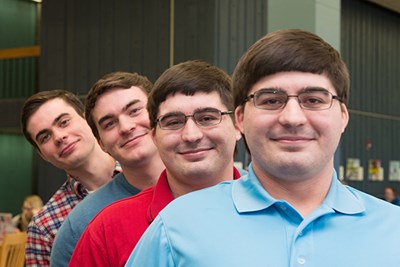Exhibits Demonstrate Creativity in Action
 Image by Edwin L. Aguirre
Image by Edwin L. Aguirre
From left: Electrical engineering (EE) seniors James Fleury and Jonathan Robinson, team mentor Shiraz Inam ’04 and EE senior Joseph Yassa show with their button-activated robotic arms with hands.
05/18/2017
By Edwin L. Aguirre
Billed as a celebration of invention and ingenuity, the university’s first-ever Invitation to Innovation (i2i) event drew a crowd of more than 1,000 to see student projects, research and products coming out of the university’s labs and classrooms.
Visitors from 37 local middle schools and high schools as well as businesses and community organizations attended the event, held at the Tsongas Center. On display were student capstone projects, with work ranging from robotics and “smart” technology to advanced materials and sustainable design.
The event, hosted by the Francis College of Engineering, Kennedy College of Sciences and Zuckerberg College of Health Sciences, also shone a light on research conducted by university faculty, products made by startups based at the UMass Lowell Innovation Hub business incubator and work by students from across the university who are participating in the DifferenceMaker program. On hand to talk to attendees and exhibitors were Engineering Dean Joseph Hartman, Sciences Dean Noureddine Melikechi and Health Sciences Dean Shortie McKinney.
 Image by Edwin L. Aguirre
Image by Edwin L. Aguirre
From left: Corey Garrigan, Sarah Buono, Tyler Allen and Matt Dolan (all mechanical engineering) demonstrate the 3D-printed propeller with variable-pitch blades that they had designed and built for this year’s “R2AK: Race to Alaska” competition.
“The event celebrated the spirit of entrepreneurship and ingenuity at the university as well as the achievements of our students and faculty,” said Hartman. “People saw how students have applied classroom theory and hands-on learning to develop products, prototypes and projects that address real-world challenges.”
“We are inspired every day by the enthusiasm, passion and innovation our students exhibit as they tackle these challenges. We hope the celebration provided the attendees with a glimpse of the great work taking place at the university, and that they were inspired too,” said Melikechi.
Some of the projects on display at the event included:
Button-Activated Robotic Arm with Hand. Engineering students worked with the Professional Center for Child Development, a nonprofit organization based in Andover, to assist children who are unable to perform daily tasks because of physical disabilities or neurological disorders. The students designed and built prototypes of pole-mounted robotic limbs with hands that allow children to push a ball, hold a cup and pour it and do high-fives.
R2AK: Race to Alaska. A team competing in the 750-mile sailboat race from Port Townsend, Wash., to Ketchikan, Alaska, this June had asked students to design and fabricate a human-powered propulsion system for a 20-foot-long catamaran. No motors are allowed in the race, so the students created a light, compact 3D-printed propeller operated by pedal power that has variable pitch blades.
 Image by Edwin L. Aguirre
Image by Edwin L. Aguirre
Standing, from left: UML River Hawk Racing team members Rafaella Gomes (mechanical engineering), Siddhant Iyu (plastics engineering), Kevin Nguyen (mechanical engineering) and Spencer Culpepper (mechanical engineering) pose with the Formula SAE race car driven by Zack Tenaglia (mechanical engineering).
Formula-style Race Car. Students in the UMass Lowell River Hawk Racing team have designed and built a fourth-generation car to compete in the Formula SAE International collegiate race in Michigan this May. The 410-pound race car, which is powered by an 86-horsepower Honda engine and can accelerate from 0 to 60 miles per hour in less than 5 seconds, will race 117 other teams from the United States, Canada, Austria, Germany, Mexico, Venezuela, Brazil, South Korea and Singapore.
High-powered Model Rocket. Members of the UMass Lowell Rocketry Club built a rocket that is scheduled to be launched from Berwick, Maine, this June. The 6½-foot-long fiberglass rocket, powered by a solid-propellant motor, is designed to reach up to a mile in altitude. It will be equipped with a digital camera and instruments to measure atmospheric temperature and pressure, as well as parachutes and a GPS transmitter to assist in the recovery. The students plan to compete in next year’s NASA Student Launch competition in Huntsville, Ala.
A Student-built Satellite Going into Earth Orbit. A team of undergraduate students from the Kennedy College of Sciences and the Francis College of Engineering is testing a miniature satellite that will be delivered to NASA next year. The project—named SPACE HAUC (pronounced “Space Hawk”), which stands for Science Program Around Communications Engineering with High-Achieving Undergraduate Cadres—is funded by a two-year, $200,000 grant from the space agency.
 Image by Edwin L. Aguirre
Image by Edwin L. Aguirre
From left: UML Rocketry Club members Justin Brelling, William Kammerer and Shawn Griffin (all mechanical engineering) display their 6½-foot-long high-powered model rocket.
Sheet Music Editor. Two computer science majors, Matthew DiBello and Doug Salvati, combined their love for music and programming to create an interactive app for writing, editing, playing and exporting sheet music. Sample songs can be uploaded into the program to let users play and edit the pieces and see (and hear) what their changes do to the music.
In addition to exhibits on the arena floor, the Solomont School of Nursing mobile lab, parked outside the building, gave visitors a sneak peek into the health care profession. Inside the lab, people could take the pulse and listen to the breathing of an adult patient simulator, a computerized, high-tech mannequin with realistic anatomy and clinical functionalities.
“We hope i2i would inspire students in middle and high school and that they would get a sense of what they can achieve with an education in the science, technology, engineering and math fields,” said McKinney.
Tech companies, including Analog Devices, Tektronix, GrabCAD, Gap Wireless, Newark Element 14, Keysight, Skyworks, Symbotic, Brooks Automation, Ma/Com, Raytheon, BAE Systems, Raytheon, Nypro and United Technologies, sponsored the event.




